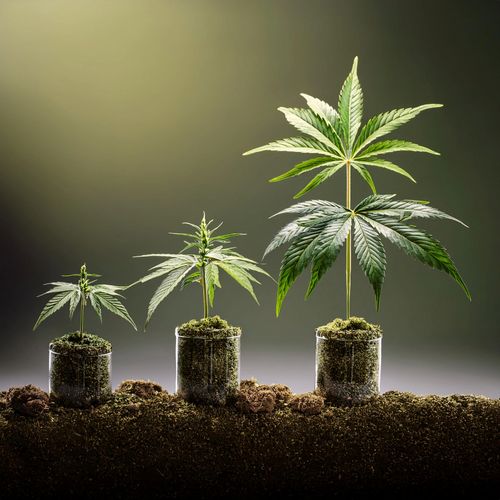
The vegetative phase of cannabis is one of the most crucial phases in the entire life cycle of the plant and can make the difference between a successful harvest and a less productive production. In this blog post, we will go over the different aspects of the vegetative phase and offer you useful tips on how to create the best conditions for your cannabis plants.
1. What is the growth phase?
The growth phase (also called vegetative phase) is the period in which the cannabis plant is mainly building its green structures such as leaves and stems, but is not yet forming flowers. It follows directly after germination and lasts until the transition to the flowering phase. This phase is crucial for the growth of the plant and the development of a strong root system, which can have a positive effect on flowering later on.
During this phase, the focus should be on the healthy and strong development of the plant. Optimal conditions for light, temperature, humidity and nutrients are crucial to ensure strong and resilient plant growth.
2. The right lighting conditions
Light is the most important factor to promote the growth phase of cannabis in indoor growing. Cannabis is a plant that needs a lot of light to grow healthily. During the vegetative phase, cannabis plants usually need 18 to 24 hours of light per day. The more light you give them, the faster and stronger they will grow.
Lamp choice: LED lamps and high pressure sodium (HPS) lamps are the most popular options for indoor growing. LEDs are more energy efficient and provide the full spectrum of light necessary for cannabis growth. HPS lamps are also good for the vegetative phase as they provide intense light, but at the cost of higher energy consumption and heat generation.
Light intensity: Make sure your plants get enough light, but not so much that they burn. A good rule of thumb is to position the lights about 30 to 60 cm above the plants, depending on the type of light. Monitor the plants regularly and look for signs of light stress such as burnt leaves.
3. Temperature and humidity
The right temperatures and humidity are crucial for the growth of cannabis in the vegetative phase. Cannabis prefers a temperature of around 22 to 28 degrees Celsius during the day and 18 to 22 degrees Celsius at night.
Temperature: Cannabis is relatively sensitive to temperature. Temperatures that are too high (above 30°C) can cause stress and slow growth, while temperatures below 18°C can inhibit plant growth. Make sure your ambient temperature remains stable to avoid stress and growth problems.
Humidity: During the vegetative phase, humidity levels of around 40-70% are ideal. Too low humidity can reduce evaporation and stunt plant growth, while too high humidity increases the risk of mold and other diseases. Use a hygrometer to monitor humidity levels and make sure it stays within the optimal range.
4. Nutrients and pH
Cannabis requires certain nutrients during the growth phase to thrive healthily. The most important ones are nitrogen (N), phosphorus (P) and potassium (K). Nitrogen is the most important nutrient during this phase as it promotes leaf growth and the overall development of the plant.
Nutrient supply: Make sure you use fertilizers suitable for cannabis. A good ratio of nutrients (e.g. 3-1-2 or 4-1-3 for nitrogen, phosphorus and potassium) will support the healthy development of the plant. Make sure to add the nutrients in the right amount, as over-fertilization can also be harmful.
pH: The pH of the water and substrate is also very important. Cannabis prefers a pH of around 5.8 to 6.5 in soil and 5.5 to 6.0 in hydroponic systems. An incorrect pH can affect the absorption of nutrients and lead to deficiencies. Use a pH meter to make sure the level is within the ideal range.
5. Irrigation
Watering is another important aspect of growing during the vegetative phase. Cannabis needs regular water, but it's equally important that the soil or substrate drains well to prevent root rot. Avoid overwatering your plants - wait until the top layer of soil is dry before watering again.
Water quality: The water you use should be free of chemical contaminants such as chlorine. If you use tap water, it is best to let it sit overnight to allow the chlorine to evaporate, or use filtered water.
6. Training techniques for optimal growth
During the vegetative phase, you can use different training techniques to optimize the growth of your plants. Some of the most popular techniques are:
- Low Stress Training (LST): This method involves gently bending and fixing the plant stem to promote more even growth and encourage the plant to produce more side shoots, resulting in a higher yield.
- Topping: This involves cutting the main stem above a certain node to encourage the plant to develop multiple main shoots.
- Defoliation: Removing less vital leaves can improve airflow and bring more light to the lower parts of the plant.
Conclusion
The cannabis vegetative phase is a crucial time that sets the stage for later flowering and harvest. By creating the right conditions for light, temperature, humidity, nutrients and watering, and applying training techniques where necessary, you can optimize your plants' growth and lay the foundation for a bountiful harvest.
Each plant is unique, so be sure to monitor it regularly and respond to any signs of stress or nutritional deficiencies. With the right care, you will guide your cannabis plants through to the flowering stage and ultimately reap a successful harvest.
